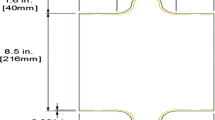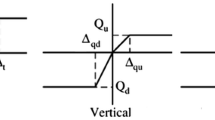Abstract
A buried pipe extends over long distances and passes through soils with different properties. In the event of an earthquake, the same pipe experiences a variable ground motion along its length. At bends, geometrically a more complicated problem exists where seismic waves propagating in a certain direction affect pipe before and after bend differently. Studying these different effects is the subject of this paper. Two variants for modeling of pipe, a beam model and a beam-shell hybrid model are examined. The surrounding soil is modeled with the conventional springs in both models. A suitable boundary condition is introduced at the ends of the system to simulate the far field. Effects of angle of incidence in the horizontal and vertical planes, angle of pipe bend, soil type, diameter to thickness ratio, and burial depth ratio on pipe strains at bend are examined thoroughly. It is concluded that extensional strains are highest at bends and these strains increase with the angle of incidence with the vertical axis. The pipe strains attain their peaks when pipe bend is around \(135^{\circ }\) and exceed the elastic limit in certain cases especially in stiffer soils, but remain below the rupture limit. Then equations for predicting the seismic response of the buried pipe at bend are developed using the analytical data calculated above and regression analysis. It is shown that these semi-analytical equations predict the response with very good accuracy saving much time and effort.























Similar content being viewed by others
References
American lifelines alliance (ALA) (2001) Guidelines for the design of buried steel pipe (with addenda through 2005). American Society of Civil Engineers
American Petroleum Institute (2000) Specificarion for line pipe. API specification 5L, Forty-Second Edition
American Society of Civil Engineers (1984) Guidelines for the seismic design of oil and gas pipeline systems. Committee on Gas and Liquid Fuel Lifelines Technical Council on Lifeline Earthquake Engineering, New York
Berrones RF, Liu XL (2003) Seismic vulnerability of buried pipelines. Geofisica Internacional 42(2):237–246
Bowles JE (1996) Foundation analysis and design. The McGraw-Hill Companies, NY
Chopra AK (1995) Dynamics of structures: theory and application to earthquake engineering. Prentice-Hall, Englewood Cliffs
Dash SR, Jain SK (2008) An overview of the seismic considerations of buried pipeline. J Struct Eng 34(5): 349–359
Datta TK (1999) Seismic response of buried pipelines: a state-of-the-art review. Nucl Eng Des 192:271–284
Goodling EC (1983) Buried piping—an analysis procedure update. In: Proceedings international symposium on lifeline earthquake engineering, Portland, Oregon, ASME, PVP-77: 225–237
Halabian AM, Hokmabadi T, Hashemolhosseini SH (2008) Numerical study on soil-HDPE pipeline interaction subjected to permanent ground deformation. The 14th world conference on earthquake engineering, Beijing, China
Hart JD, Zulfiqar N, Lee CH, Dauby F, Kelson KI, Hitchcock C (2004) A unique pipeline fault crossing design for a highly focused fault. In: Proceedings of IPC, international pipeline conference, Calgary, Alberta, Canada
Hatzigeorgiou GD, Beskos DE (2010) Soil-structure interaction effects on seismic inelastic analysis of 3-D tunnels. Soil Dyn Earthq Eng 30:851–861
Hindy A, Novak M (1979) Earthquake response of underground pipelines. Earthq Eng Struct Dyn 7:451–476
Horikawa H, Suzuki N (2009) Bending deformation of x80 cold bend pipe. In: Proceedings of the nineteenth international offshore and polar engineering conference, Osaka, Japan
Japan Gas Association (JGA) (2000) Seismic design guideline of high-pressure gas pipelines. Japan Gas Association
Karamanos SA, Giakoumatos E, Gresnigt AM (2003) Nonlinear response and failure of steel elbows under in-plane bending and pressure. J Press Vessel Technol 125(4):393–402
Karamanos SA, Tsouvalas D, Gresnigt AM (2006) Ultimate bending capacity and buckling of pressurized 90 deg steel elbows. J Press Vessel Technol 128(3):348–356
Kishida H, Takano A (1970) The damping in the dry sand. The proceeding of 3rd Japan earthquake engineering simposium, Tokyo, Japan
Kouretzis GP, Bouckovalas GD, Gantes CJ (2006) 3-D shell analysis of cylindrical underground structures under seismic shear (S) wave action. Soil Dyn Earthq Eng 26:909–921
Kouretzis GP, Bouckovalas GD, Gantes CJ (2007) Analytical calculation of blast-induced strains to buried pipelines. Int J Impact Eng 34:1683–1704
Lee DH, Kim BH, Lee H, Kong JS (2009) Seismic behavior of a buried gas pipeline under earthquake excitations. Eng Struct 3:1011–1023
Liu AI, Hu YX, Zhao FX, Li XJ, Takada S, Zhao L (2004) An equivalent-boundary method for the shell analysis of buried pipelines under fault movement. Acta Seismol Sinica 17:150–156
Lysmer J, Kuhlemeyer AM (1969) Finite dynamic model for infinite media. J Eng Mech Div 95(4):859–877
Mclaughlin PM, O’Rourke M (2003) Seismic response and behavior of buried continuous piping systems containing elbows. Doctoral Thesis, Rensselaer Polytechnic Institute
Mclaughlin PM, O’Rourke M (2009) Strain in pipe elbows due to wave propagation hazard. Lifeline Earthquake Engineering in a Multihazard Environment, ASCE
Muthmann E, Grimpe F (2006) Fabrication of hot induction bends from LSAW large diameter pipes manufactured from TMCP plate. Microalloyed steels for the oil and gas industry international symposium, Araxa, Brazil
Newmark NM (1968) Problems in wave propagation in soil and rock. In: Proceedings of international symposium on wave propagation and dynamic properties of earth materials, August 23–25, Univ. of New Mexico Press, Albuquerque: 7–26
Ogawa Y, Koike T (2001) Structural design of buried pipline for sever earthquake. Soil Dyn Earthq Eng 21:199–209
O’Rourke MJ, Liu X (1999) Response of buried pipelines subject to earthquake effects. MCEER Monograph Series, Multidisciplinary Center for Earthquake Engineering Research
O’Rourke TD, Wang Y, Shi P, Jones S (2004) Seismic wave effects on water trunk and transmission lines. In: Proceedings of the 11th international conference on soil dynamics and earthquake engineering and 3rd international conference on earthquake geotechnical engineering. Berkeley, CA 2:420-428
O’Rourke MJ, El Hmadi K (1988) Analysis of continuous buried pipelines for seismic wave effects. Earthq Eng Struct Dyn 16:917–929
Pacific Earthquake Engineering Research Center, http://peer.berkeley.edu/, PEER
Pappa P, Tsouvalas D, Karamanos SA, Houliara S (2008) Bending behavior of pressurized induction bends. Offshore Mechanics and Arctic Engineering Conference, ASME, OMAE2008-57358, Lisbon, Portugal
Rofooei FR, Qorbani R (2008) A parametric study on seismic behavior of continuous buried pipeline due to wave propagation. The 14th world conference on earthquake engineering, Beijing, China
Sakurai A, Takahashi T (1969) Dynamic stresses of undergroud pipelines during earthquake. In: Proceeding of the fourth wolrd confrenece on earthquake engineering, Santiago, Chile, pp 81–95
Shah H, Chu S (1974) Seismic analysis of underground structural element. J Power Div 100:53–62
Shi P, O’Rourke TD, Wang Y, Fan K (2008) Seismic response of buried pipelines to surface wave propagation effects. The 14th world conference on earthquake engineering. Beijing, China
Stamos AA, Beskos DE (1995) Dynamic analysis of large 3-D underground structures by the BEM. Earthq Eng Struct Dyn 24:917–934
Takada S, Tanabe K (1987) Three dimensional seismic response analysis of buried continuous or jointed pipelines. J Press Vessel Technol 109:80–87
Takada S, Hassani N, Fukuda K (2001) A new proposal for simplified design of buried steel pipes crossing active faults. Earthq Eng Struct Dyn 30:1243–1257
Takada S, Carlo A, Bo S, Wuhu X (1992) Current state of the arts on pipeline earthquake engineering in japan. The construction engineering research institute foundation: 305–326
Takada S, Higashi S (1992) Seismic response analysis for jointed buried pipline by using shell FEM model. In: Proceedings of the tenth world conference on earthquake engineering pp 5487–5492
Takada S, Katagiri S (1995) Shell model response analysis of buried piplines. In: Proceedings of the fourth U.S. confrence of lifeline earthquake engineering , pp 256–263
Trifonov OV, Cherniy VP (2010) A semi-analytical approach to a nonlinear stress-strain analysis of buried steel pipelines crossing active faults. Soil Dyn Earthq Eng 30:1298–1308
Vazouras P, Karamanos SA, Dakoulas P (2010) Finite element analysis of buried steel pipelines under strike-slip fault displacements. Soil Dyn Earthq Eng 30:1361–1376
Wang Y, O’Rourke TD, Shi P (2006) Seismic wave effects on the longitudinal forces and pullout of underground lifelines. In: Proceedings of the 100th anniversary earthquake conference: commemorating the 1906 San Francisco Earthquake, San Francisco, California, Aplil 18–22
Yoshizaki K, O’Rourke TD, Hamada M (2001) Large diformation behavior of buried pipeline with low angle elbows subjected to permanent ground deformation. Proc JSCE (Japan Society of Civil Engineers) 675: 41–52
Author information
Authors and Affiliations
Corresponding author
Rights and permissions
About this article
Cite this article
Saberi, M., Behnamfar, F. & Vafaeian, M. A semi-analytical model for estimating seismic behavior of buried steel pipes at bend point under propagating waves. Bull Earthquake Eng 11, 1373–1402 (2013). https://doi.org/10.1007/s10518-013-9430-y
Received:
Accepted:
Published:
Issue Date:
DOI: https://doi.org/10.1007/s10518-013-9430-y




